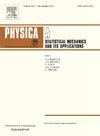On demonstrating liberating effect in complex social networks: Modeling multiple pressure-coping strategies
IF 2.8
3区 物理与天体物理
Q2 PHYSICS, MULTIDISCIPLINARY
Physica A: Statistical Mechanics and its Applications
Pub Date : 2025-06-10
DOI:10.1016/j.physa.2025.130723
引用次数: 0
Abstract
This paper introduces a novel opinion dynamics model, termed the Multiple Pressure-Coping Strategies (MPCS) mode, to investigate the opinion evolution in social networks under group pressure. The model extends the Expressed and Private Opinions (EPO) model based on the Hegselmann–Krause (HK) framework. It includes a quantifiable pressure function, heterogeneous confidence levels, a two-stage liberating effect mechanism, and a dynamic evolution of the network structure. Simulations conducted on two artificial networks and a real network demonstrate that the MPCS model is more effective in achieving consensus under conditions of initial low confidence levels and significant group pressure compared to the classic HK model. We find the critical role of initial confidence levels in consensus time. Our research highlights the impact of different pressure-coping strategies on opinion evolution. In the early iterations of evolution, agents reduce group pressure by increasing confidence levels and updating the network; in the later iterations, the liberating effect becomes pivotal in shaping opinion dynamics. The role of the liberating effect is reflected in its ability to further reduce the pressure on high-pressure nodes within the group and optimize the network structure, thereby facilitating the achievement of group consensus.
复杂社会网络中释放效应的论证:多重压力应对策略的建模
本文引入了一种新的意见动态模型——多重压力应对策略(MPCS)模型来研究群体压力下社会网络中的意见演变。该模型扩展了基于Hegselmann-Krause (HK)框架的表达意见和私人意见(EPO)模型。它包括可量化的压力函数、异质置信水平、两阶段解放效应机制和网络结构的动态演化。在两个人工网络和一个真实网络上进行的仿真表明,与经典HK模型相比,MPCS模型在初始置信度较低和群体压力较大的情况下更有效地达成共识。我们发现初始置信水平在共识时间中的关键作用。我们的研究强调了不同的压力应对策略对意见演变的影响。在进化的早期迭代中,agent通过增加置信度和更新网络来减少群体压力;在后来的迭代中,解放效应在形成舆论动态方面变得至关重要。解放效应的作用体现在能够进一步减轻群体内部高压节点的压力,优化网络结构,从而促进群体共识的达成。
本文章由计算机程序翻译,如有差异,请以英文原文为准。
求助全文
约1分钟内获得全文
求助全文
来源期刊
CiteScore
7.20
自引率
9.10%
发文量
852
审稿时长
6.6 months
期刊介绍:
Physica A: Statistical Mechanics and its Applications
Recognized by the European Physical Society
Physica A publishes research in the field of statistical mechanics and its applications.
Statistical mechanics sets out to explain the behaviour of macroscopic systems by studying the statistical properties of their microscopic constituents.
Applications of the techniques of statistical mechanics are widespread, and include: applications to physical systems such as solids, liquids and gases; applications to chemical and biological systems (colloids, interfaces, complex fluids, polymers and biopolymers, cell physics); and other interdisciplinary applications to for instance biological, economical and sociological systems.

 求助内容:
求助内容: 应助结果提醒方式:
应助结果提醒方式:


